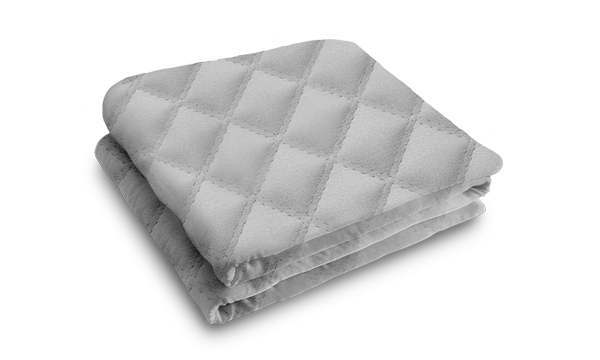The weighted blanket has become a staple in homes for its therapeutic benefits, particularly in enhancing sleep quality and providing comfort. Recognized for its ability to mimic a gentle hug, this blanket has grown in popularity. This article explores the origins of the weighted blanket, delving into its invention, the evolution over the years, and its broader impact on sleep technology, illustrating how such innovations have melded seamlessly with modern living spaces and wellness trends.
When Was the Weighted Blanket Invented?
The concept of the weighted blanket is relatively modern, with its roots tracing back to the early 1990s. It was first designed as a therapeutic tool for individuals with severe anxiety and behavioral disorders, including children with autism spectrum disorders, aiming to help them relax and sleep more deeply by providing a sense of security and comfort.
- Early Development: The first weighted blanket was developed by Keith Zivalich in California in 1997, inspired by the calming, firm but gentle squeeze of his daughter’s small lizard on his shoulders.
- Therapeutic Use: Therapists quickly recognized that the deep pressure provided by these blankets could assist patients with sensory processing disorders, effectively simulating the comforting feeling of being held or hugged, which can significantly reduce stress and enhance sleep.
Who Invented the Weighted Blanket?
Keith Zivalich, a Californian inventor, is credited with creating the first weighted blanket, sparking a new direction in therapeutic tools. His invention was sparked by a simple family moment and has since transformed into a significant tool used in both therapy sessions and everyday comfort.
- Innovation: Zivalich’s groundbreaking idea was born out of his desire to help his daughter feel calm and secure during times of anxiety.
- Evolution: Over the years, the design of weighted blankets has been refined and adapted to cater to a broader audience, incorporating various materials and weights to suit different preferences and needs, making them versatile for use in numerous household settings.
Development and Therapeutic Use of Weighted Blankets
After its invention by Keith Zivalich, the weighted blanket was quickly recognized for its therapeutic benefits, especially for individuals with sensory processing disorders. Here’s a deeper look at how it evolved into a widely used therapeutic tool:
- Therapeutic Adoption: Originally a comforting tool for Zivalich’s daughter, therapists soon began using weighted blankets more widely to help patients with sensory sensitivities associated with conditions such as autism, ADHD, and anxiety disorders.
- Scientific Support: Extensive research supports the use of deep touch pressure provided by weighted blankets as a means to reduce anxiety and improve sleep quality. This therapy mimics the feeling of being held or hugged, which has been shown to have soothing and comforting effects, aiding in relaxation and sleep.
Just as a weighted blanket provides deep touch pressure for therapeutic relief, Puffy mattresses are engineered to deliver targeted support and pressure relief, enhancing the quality of sleep and helping to alleviate discomfort throughout the night.
Expansion into Mainstream Markets
As awareness of its benefits grew, the weighted blanket transitioned from a therapeutic device to a popular household item, expanding its reach and usability:
- Broader Use: Beyond its initial therapeutic applications, weighted blankets have gained popularity among the general public for their potential to enhance sleep quality and reduce stress, becoming a favored choice for improving overall well-being.
- Variety and Innovation: Today, weighted blankets are available in various weights, sizes, and materials, catering to different age groups and personal preferences. Innovations include breathable fabrics for comfort in different climates and weighted blankets designed for couples, enhancing comfort and accessibility for a wider range of users.
In the same way that weighted blankets have become a versatile solution in many homes, Puffy mattresses offer a range of options to suit various sleeping styles and preferences, ensuring that every user can find the perfect match for a restful night’s sleep.
Impact on Modern Sleep Technology and Bedding Industry
The integration of weighted blankets into mainstream sleep technology showcases its significant impact on the bedding industry and sleep habits:
- Integration with Advanced Bedding: As sleep technology advances, products like weighted blankets are being designed to integrate with modern bedding solutions, offering enhanced comfort and functionality, and addressing a wider range of sleep-related challenges.
- Influence on Sleep Products: The concept of weighted blankets has inspired the development of other sleep products focused on using weight and pressure to provide comfort, leading to a broader range of specialized bedding solutions that cater to various needs and preferences.
Conclusion
The invention of the weighted blanket marked a significant advancement in therapeutic bedding solutions, offering a unique way to alleviate stress and improve sleep quality.
As we continue to explore and understand the benefits of deep pressure stimulation, the popularity of weighted blankets is likely to grow, paralleling innovations in sleep technology. These advancements promise to continue enhancing our quality of life, particularly in terms of sleep and relaxation.

- Lifetime Warranty
- 101-Night Sleep Trial
- Free, Contactless Delivery












